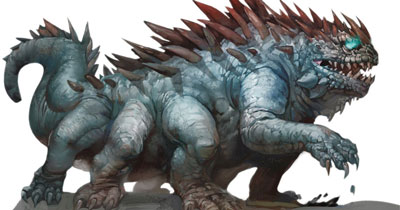By Alan McCoy from Dungeons & Dragons: Fundamentals
How to build challenging encounters against a Basilisk
Note: This has been prepared utilizing only the 5E Core Rules. The Basilisk can be found in the Monster Manual page 24.
Appearing as an eight-legged lizard, the basilisk resembles a large iguana, with man sharp protuberances on its upper side. Roughly four feet in length, not counting the tail, these creatures weigh a hundred pounds or so. The head of a Basilisk contains an oversized jaw and powerful teeth. Of course, the most impressive Structure on a Basilisk are its eyes. Survivors have described the eyes of being sparkly gemstones, that you simply could not tear your eyes away from.
A Basilisk is surprisingly slow for a hunting predator, but then its power of petrification eliminates the chance of prey escaping and nullifies the possibility of retaliation from the prey. Often the only indication that a Basilisk is in the area is the appearance of stone outcroppings and features that may resemble statues. The stone of these outcroppings is only rarely appropriate for the geology of the area.
The origin of the Basilisk is shrouded in mystery, the most common theories are: Escaped Magical Experiment and Curse or Perversion of a beneficial or useful creature into a monster by forces that are opposed to the Gods of Creation.
Basilisks are usually solitary and are also territorial, there are tales of a Basilisk being fooled by and attacking it’s own reflection.
While attempts to harvest and utilize the Eyes of a Basilisk have rarely proven fruitful, the oil harvested from the gullet of a Basilisk has proven useful as a reagent. It can dissolve the stone of the prey, allowing the Basilisk to consume the flesh of its prey. Properly prepared, this oil can be used to return petrified creatures to flesh and life.
Step 1) Let’s Review what we know about the Basilisk
The Basilisk is extraordinarily strong, and extremely tough. It moves poorly, has a limited sense of self preservation and an instinctual animal intelligence.
The Basilisk has a walking speed of 20 feet per round.
The Basilisk has Darkvision of 60 feet, and a passive perception of 9.
Step 2) Determine the probable Strategy/Tactics
An extremely slow hunting predator, the Basilisk does not need to hunt often, as its former kills are preserved until it chooses to consume them. When it does hunt, the Basilisk will wander toward its chosen prey, making as much noise and commotion as possible. It wants to be sure that everyone can see it and will be looking at it when it makes an appearance from concealment.
The instinct says that once prey caught by the petrifying gaze, all that’s left is digestion.
A Basilisk’s primary weapon is its petrifying gaze, but it also has a nasty bite, that inflicts piercing and poison damage.
Step 3) DM Tips and Observations
I have rarely seen a creature so hamstrung. The primary ability of the Basilisk has had almost all the utility carved out of it. One DC 12 Saving throw to be restrained. A second to begin the Petrification process. Add into this – The save is vs Constitution. Usually quite high for most player characters.
I suggest instead: The gaze attack is CONE Shaped 180 degrees (half circle) requiring a DC 15 STRENGTH SAVE, for those who have not specifically averted their eyes. Failure = -1d6 Strength points and applies the RESTRAINED condition.
Subsequent gaze attacks reduce Strength by a like amount, when STRENGTH equals ZERO, the prey is petrified.
Strength is restored at 1 point per hour or by a Short Rest.
The image of the creature shown in the monster manual displays an impressive set of claws, when you consider that the Basilisk has eight legs, it would be reasonable to upgrade the physical attacks of the Basilisk to:
Multi-Attack: Claw, Claw, Bite
Claw: +5, Reach 5 feet, Damage: 1d8+3 Slashing.
Bite: +5, Reach 5 feet, Damage 2d6+3 and 2d6 Poison.
